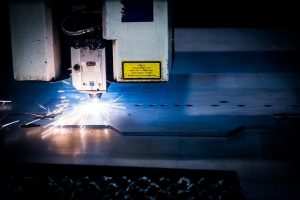
The terms “plasma cutting” and “laser cutting” are often used interchangeably when referring to the use of hot, high-powered light to cut through workpieces. While similar, though, they aren’t necessarily the same. Plasma cutting and laser cutting use entirely different mechanisms to perform cutting processes. So, what’s the difference between plasma cutting and laser cutting exactly?
What Is Laser Cutting?
Originating in the mid-1960s, laser cutting is a cutting process that’s characterized by the use of amplified laser light. It’s typically performed using a computer, such as a computer numerical control (CNC), allowing for extreme precision when cutting workpieces. The laser light is focused into a small point with the help of optics. As the laser light enters the optics, it becomes smaller and hotter. The focused laser beam is then able to cut through workpieces as dictated by the computer.
There are three primary types of lasers used in laser cutting: CO2, neodymium (Nd) and yttrium-aluminium-garnet (Nd:YAG). Each of the three lasers has its own unique advantages and disadvantages. CO2 lasers, for example, are ideal for both cutting and engraving, whereas Nd lasers are better suited for cutting applications that require a substantial amount of energy. Regardless, CO2, Nd and Nd:YAG lasers all use amplified laser light to cut workpieces.
What Is Plasma Cutting?
Originating in the 1950s, plasma cutting is an alternative cutting process that’s characterized by the use of a plasma torch. The plasma torch creates a hot jet of plasma that’s able to melt through even the toughest materials. When activated, the plasma torch will project a mixture of gases, including nitrogen and hydrogen, through the nozzle, which subsequently creates plasma.
Contrary to what some people believe, plasma cutting doesn’t use fire or a flame. Instead, it uses conductive ionized gas, which is also known as plasma. To say plasma is hot would be an understatement. While temperatures can vary depending on the specific type of plasma torch, as well as other factors, it’s not uncommon for plasma to reach 40,000 degrees Fahrenheit.
Workers who perform plasma cutting must wear the appropriate personal protective equipment (PPE) to protect against arc eye. Also known as photokeratitis or ultraviolet keratitis, arc eye is an injury that occurs when a worker’s eyes are exposed to high levels of radiation. Because plasma torches emit radiation, workers must wear protective glasses or goggles to protect against eye arc. Laser cutting, on the other hand, does not produce or emit radiation.
In Conclusion
Both laser cutting and plasma cutting are capable of cutting metal workpieces. As previously explained, though, they work in completely different ways. Laser cutting uses amplified laser light, whereas plasma cutting uses plasma.
